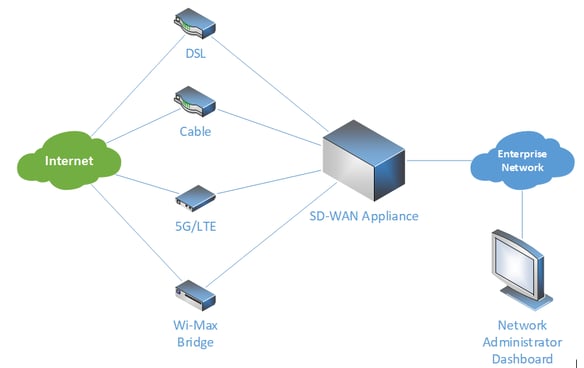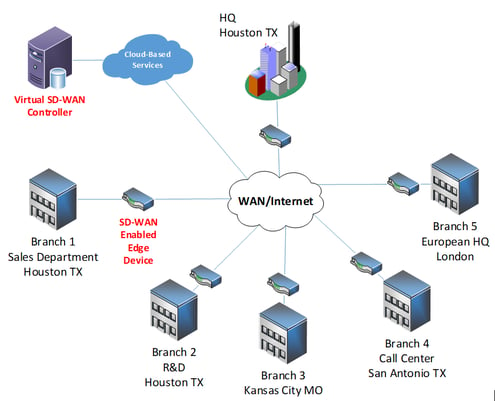
A software-defined wide area network (SD-WAN) is a concept that has been around for over a decade. Even so, there are still many areas of this technology that are difficult to fully understand, especially for administrators and decision-makers whose expertise lies elsewhere. However, it is important for people in management positions to be aware of the benefits of SD-WANs because they are becoming increasingly essential as cloud-based services become more ubiquitous.
In this article, we shed light on SD-WANs and their usefulness in modern networks.
SD-WAN basics
An SD-WAN is a subset of software-defined networking, a network design approach that enables you to manage a network, which is composed of dozens or hundreds of network devices, in a centralized manner. SD-WANs specifically deal with the network edge; that is, the portion of the network that interconnects with the outside world. This can include interconnections with private WANs for multisite organizations, as well as public networks, such as the PSTN and the internet.
An SD-WAN employs the use of a centralized controller from which all WAN connections can be managed simultaneously, whether those WAN connections exist only at a single physical location or within a framework of a multisite enterprise. Practically speaking, this means that all WAN connections can be managed from a single controller or dashboard. This is extremely helpful because it allows for a more consolidated management of such connections, as well as a massively improved streamlining of operations.
Why SD-WANs are so useful
There are a multitude of benefits to SD-WANs. These include:
- Simplified management – With an SD-WAN controller, network administrators are able to control all WAN connections as a single entity. SD-WAN controllers provide a high-level configuration environment where general parameters can be defined. The controller is then smart enough to send the appropriate commands to the appropriate network devices to achieve the desired results. What in the past would have taken several days of designing and several hours of implementation, today can be achieved with several clicks on an SD-WAN dashboard.
- Improved security – SD-WAN controllers are able to employ multiple layers of security on their managed WAN connections, even if the managed WAN connections don’t inherently deliver high security.
- Consolidation of multiple WAN connections – SD-WANs are capable of consolidating multiple types of WAN connections, resulting in an increase in efficiency, resilience, and quality of service compared with the use of any one of those technologies alone. This results in:
- A decrease in cost
- An increase in throughput
- Dynamic traffic engineering based on changing traffic patterns and parameters
- An increase in redundancy and availability
- Application optimization – SD-WAN technology can improve application delivery using caching. This results in the local storing of recently accessed information in memory to speed up future access. This is especially useful in cloud-based application delivery.
How SD-WANs are deployed and delivered
All of this theory is great, but when we talk about SD-WAN deployment, what do we actually mean? What is physically being installed, where is it installed, and how does it work practically? There are several ways that an SD-WAN can be deployed.
SD-WAN appliance
Arguably, the simplest is in the form of an all-in-one SD-WAN appliance, which has the capability of connecting multiple WAN connections on one end and delivering network connectivity internally to an enterprise network. The following diagram illustrates such an arrangement:

The appliance enables load-balancing, security, resilience, quality of service, and application optimization, and intelligently decides how and via which path to route specific types of traffic. This scenario further describes how consumer-grade WAN connections, when consolidated, can deliver high-grade services comparable with those offered via much more expensive fiber optic and metro-ethernet connections.
Cloud-based SD-WAN
In somewhat more complex scenarios where there are several remote branch offices, interconnections between sites, and connectivity to the internet, the above arrangement is not as flexible. In such cases, a cloud-based SD-WAN service is preferable. Consider the following diagram:

In this scenario, this multisite enterprise has several SD-WAN-enabled edge devices at each location. These devices are controlled via the virtual SD-WAN controller found on the cloud. Administrators can log into the controller and configure the WAN network as a whole.
From the single controller, interconnectivity between sites can be configured, quality of service parameters can be set, security and accessibility between sites can be defined, and allowed internet connectivity can be configured. Such SD-WAN solutions are also called SD-WAN as a service (SD-WANaaS) and use the SaaS cloud service model. Such services are most often subscription-based and are highly customizable, allowing you to purchase only the services and features that are useful to you. This solution is also more scalable and modifiable, which is essential, especially for fast-growing and evolving enterprises.
Most of our ITSP partners offer SD-WAN. For more information, contact your TeleDynamics rep or visit the preferred partners page on our website.
Why SD-WANs are so important
The WAN is becoming more and more important, especially because of the proliferation of cloud-based applications. By definition, such applications require a WAN connection. As more and more cloud applications are used, many of which are mission-critical to a multitude of enterprises, the WAN connection is becoming a more essential part of business.
This is why resilience, bandwidth, quality of service, and availability are no longer simply a luxury that only the largest enterprises can enjoy, but a necessity even for SMEs leveraging the cloud.
Among the most important mission-critical, cloud-based business services offered today are:
- Telecommunications services, including telephony, contact centers, and voice- and video-based customer service offerings are an integral part of many companies. They often rely heavily on voice and/or video communication with their customers and their business partners. Collaboration services like Teams or Slack are also a very important part of the operation of many enterprises.
- Business applications, such as CRM, helpdesk, ticketing, financial services, email and web services are all applications that are largely offered on the cloud.
- Backup and storage, including cloud-based file sharing, as well as backup and storage, are crucial for many businesses to operate.
Conclusion
The WAN is becoming a mission-critical service for enterprises of today, and as time goes on, the reliance of businesses on the WAN is expected to increase even further. SD-WAN technologies are an excellent way of simplifying deployment and management while increasing resilience, availability, and bandwidth, as well as decreasing costs.
You may also like:
How to optimize your WAN connectivity for VoIP
Key considerations for choosing a high-grade WAN technology
Know your stuff: Commercial-grade WAN technologies









Comments